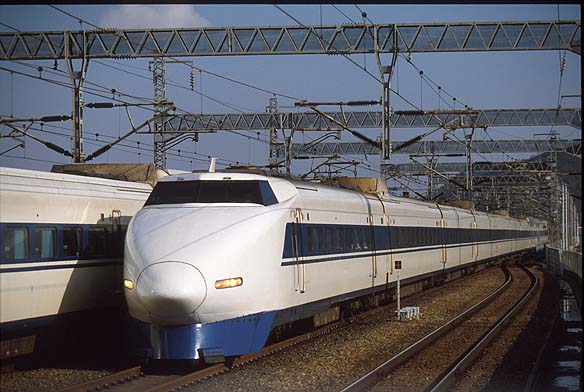Japan National Railways (JNR) developed 100 series trains as the second-generation
Shinkansen type for use on the Tokaido and Sanyo Shinkansen, in order to
displace 0 series built for over 20 years after the start of operation on the Tokaido Shinkansen.
Traction systems, which control more powerful traction motors rated at
230kW, adept thyristor phase control that was developed for use of 200
series. Despite the inclusion of 4 trailer cars, a maximum speed of 260
km/h was technically possible, with powerful motors and weight reduction
measures. The brake system is changed into the electric command brake such
as 200 series. As with the earlier 0 series trains, rheostatic braking
was used on motored axles. Trailer cars however, were fitted with eddy-current
braking (ECB) with discs on the axles to absorb kinetic energy. 100 series
adopt 2 cars unit as with 0 series. Vehicles of the odd number types are
equipped with the traction system, and vehicles of the even number types
are equipped with the transformer and the rectifier. Since each unit is
fitted with the cross-arm pantograph, a 16-car formation is fitted with
6 current collectors. Since it was possible to reduce the number of current
collectors to three with adopting new auto transformer (AT) feeder system
for the Tokaido Shinkansen, environmental noise, which had been a problem
with the original 0 series, was lessened.
2 trailer cars were bilevel. One bilevel car was a restaurant car which
had a restaurant area on the upper deck with kitchen facilities and a small
buffet counter on the lower deck. The other bilevel car was fist class
car that had private compartments for first class passengers on the lower
deck, with open-plan first class accommodation on the upper deck. Standard
class seating is adjustable reclining and can be rotated to face the direction
of travel. Seat pitch is 1040mm. Pre-production vehicles built in 1985
differed from later production vehicles in having small windows aligned
with each seating bay. Mass-production vehicles have the wide windows.
Although bogies are similar to those of 0 series, some improvements on bogies ensured smoother ride characteristics.
After the splitting of the former JNR into the new privatized JR companies
in April 1987, JR Central built 100 series vehicles in order to displace
with superannuated 0 series vehicles and classified into G set. They featured
two bilevel first class cars in place of the type 168 restaurant car. Newly
launched bilevel car has open-plan green car accommodation on the upper
deck, and a self-service cafeteria area on the lower deck. Standard class
accommodation adopt simple footrest in later built batches.
While 100 series were used exclusively on "Hikari" services,
in later years, 100 series vehicles used on "Hikari" services
were gradually displaced with 300 series or later series and began to be
used on Tokaido Shinkansen "Kodama" services. X sets were withdrawn
in 2000 and G sets transferred to JR West were withdrawn in 2003. Some
G set vehicles were remodeled into -5050 sub-series and used in Sanyo Shinkansen
"Kodama" services. |
|
| Technical Data |
| Items |
Data |
| Built |
1985-1992 |
| Construction |
Steel |
| Formation |
12M-4T |
| Supply
voltage |
25,000VAC,
60Hz |
| Service
speed, etc. |
Acceleration:
1.6km/h/s Service speed: 220km/h |
| Length |
26,050mm
(End cars) 25,000mm (Intermediate cars) |
| Width |
3,380mm |
| Height |
4,115mm |
| Bogie |
DT202
(motored) TR7000 (trailer) |
| Collector |
PS202
Cross-arm (3 per 16-car train) |
| Traction
motor |
MT202
(230kW) |
| Gear
ratio |
2.41 |
| Transformer |
TM203 |
| Rectifier |
RS203 |
| Controller |
CS56 |
| Air
conditioner |
AU83 |
| Designed
by |
Japan
National Railways |
|
|



